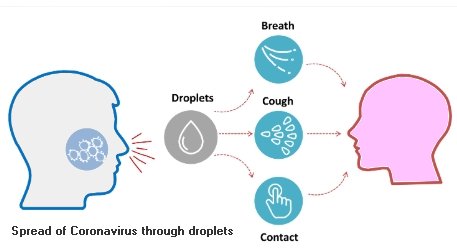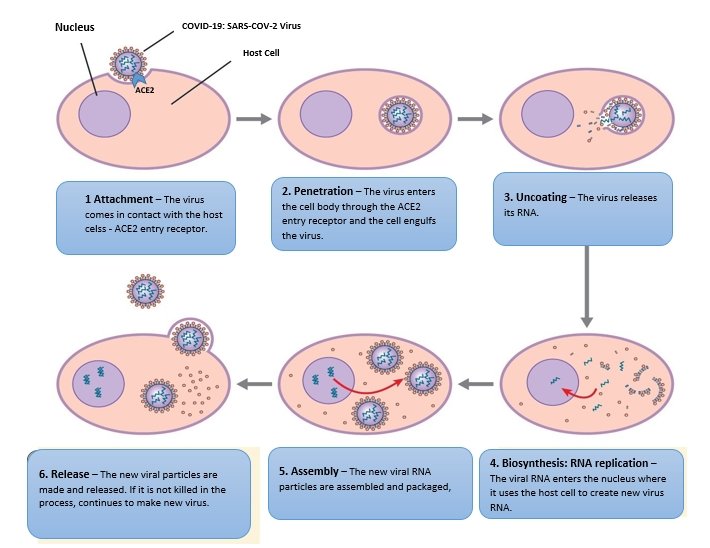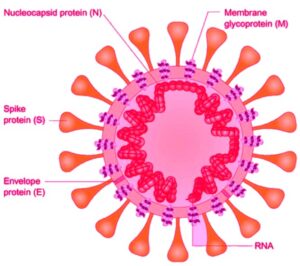In this article we reviewed five key Ayurveda techniques to fight against Coronaviruses. The global COVID-19 pandemic is killing hundreds of people across the world. Modern medicine is in search of proper COVID-19 vaccine for the SARS-CoV-2 virus, but it will take at least a year to develop the vaccine. Hence, social distancing, hand washing, wearing face-masks and improving immunity are the key tools to fight against Coronaviruses. Here, we discusses the top five Ayurveda techniques to improve immunity, repairing and strengthening the throat tissues and fight against COIVD-19. Earlier, we discussed, how yoga breathing can help us to remove stress and improve immunity against COVID-19 viruses.
Ayurveda to Fight Against Coronavirus
Yoga exercises, Ayurveda and healthy lifestyle can substantially improve your immune system and can do remarkable jobs to fight against COVID-19 viruses. The coronavirus SARS-CoV-2 directly attacks the upper respiratory system, leading to the disease. This can be stopped by hard physical distancing, hand washing, wearing face-masks and by improving the immunity of the body.
The immune system unleashes a massive defense to stop the COVID-19 virus from spreading. In the process, millions of immune system cells attack the virus. If the defense system is not strong enough, the virus infects the throat and the lung tissues. This leads to shortness of breath, dry cough and other complications.
Good immunity provides resistance to virus infections in multiple levels. Building strong immunity is the golden rule of yoga and Ayurveda to fight against viruses. It requires balance and harmony in your body, mind, emotions, diets, sleep pattern and the environment. However, food supplement products suggesting pill to "boost" your immunity is often misleading.
In the traditional Allopathy medical approach, the focus is on the manifest state of illness or the sequence of events that leads to the creation of an illness, and then following the testings and the treatments. Ayurveda focuses on prevention of illness at the early stage by handling the imbalances while they are in their infancy and eliminating them with mild but effective non-obtrusive methods.
Ayurvedic medications have stood the test of time for 5000 years. There are two types of Ayurveda systems in India - the first one is the Classical Ayurveda System as explained and documented in the ancient texts, and the second one is the Family Ayurveda Tradition System, which is continuing through oral traditions and practices in different family systems. We will discuss here the top five Ayurveda techniques to improve immunity and fight against COIVD-19:
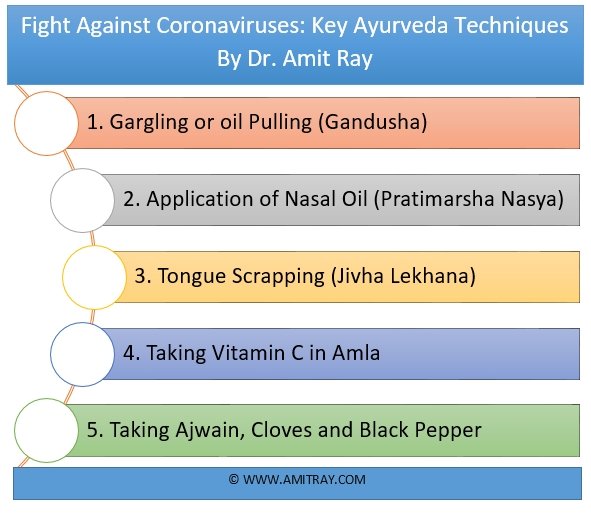
1. Gargling or oil Pulling (Gandusha)
Recently researchers observed that the COVID-19 viral RNA concentrations is maximum in the upper respiratory tract manly in the mouth, throat and the salivary glands. A detailed analysis of cases of COVID-19 in Germany showed, live replicating corona viruses was found mainly in the throat area. Studies published in the Lancet found that higher concentration of COVID-19 viruses was associated with severe clinical outcomes. They observed that virus concentration in severe cases were 60 times higher than the mild cases. These observations suggests that keeping the mouth, throat and the salivary glands clean, clear and healthy is the key to fight against coronaviruses.
Gargling or the Ayurvedic system of Oil Pulling keeps the throat, salivary glands and the mouth clean and clear.
Gargling or Oil Pulling ( called Gandusha in the traditional Ayurveda): Oil pulling is an ancient Ayurveda procedure that involves swishing oil in the mouth for oral and systemic health benefits. It is mentioned in the Avurvedic text Charaka Samhita where it is called Kavala or Gandusha and is claimed to cure about 30 systemic diseases. Sesame oil or coconut oils are commonly used for oil pulling.
The technique involves swishing a tablespoon of oil in your mouth on an empty stomach in the morning for around 2 to 10 minutes. This action supposedly draws out toxins from your body, which primarily improves oral and throat health but also improves your overall health and strengthens the respiratory system. However, ordinarily gargling can be also done with warm salt water.
2. Application of Nasal Oil (Pratimarsha Nasya)
Apply few drops of sesame oil or coconut oil in both the nostrils in the morning and while going out of your house. You can also do this, in case you feel some nasal discomfort, congestion or the beginning of watery nose symptom. In such cases, rosemary, Eucalyptus and lavender oils provide particular benefits.
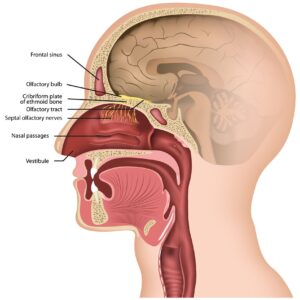 The drugs administered through nostril reach the brain, eyes, ears, upper respiratory tract, oral cavity and neck region and cure the diseases of respective organs. Before going out of house moisten the nasal cavity with oil. "Anu Tailam" is a classical oil preparation, mentioned in Ashtanga Hridaya (an authoritative Ayurveda text) to cure and prevent various diseases and systemic disorders. In Ayurveda, this Kriya is called Pratimarsha Nasya, and it is indicated to use before going outside.
The drugs administered through nostril reach the brain, eyes, ears, upper respiratory tract, oral cavity and neck region and cure the diseases of respective organs. Before going out of house moisten the nasal cavity with oil. "Anu Tailam" is a classical oil preparation, mentioned in Ashtanga Hridaya (an authoritative Ayurveda text) to cure and prevent various diseases and systemic disorders. In Ayurveda, this Kriya is called Pratimarsha Nasya, and it is indicated to use before going outside.
The process is performed after washing the hands, taking a few drops of coconut oil, sesame oil, ghee (clarified butter) or lavender oil on your left palm and then dipping the clean little finger of the right hand in the oil and inserting it into each nostril (in the nasal cavity at comfortable length), softly lubricating the nasal passage (2/3 of the nasal length) with gentle massage.
The Ayurveda sages probably knew that there are a host of nerves ending in our nasal cavities, and hence, the application of oil can directly affect our brains through the olfactory nerves, and the brain, in effect, takes necessary actions to strengthen the immune system for fighting the alien viruses. The nasal Kriya helps to clean the nose and open deep tissues and it can be done every day and at any time to release stress. This can be followed by warm water gargling.
Current research indicates that Monolaurin of coconut oil dissolves lipids in the fatty outer envelope of the viruses, basically disintegrating the organisms’ protective shield and causing them to be easily destroyed by the body immune system. Though monolaurin has not been studied on coronavirus, it may have some benefit in this case too.
3. Tongue Scrapping (Jivha Lekhana)
Tongue scrapping is an ancient Ayurvedic practice to clean the tongue, while brushing the teeth in morning. Ayurveda says it is ideal to use copper strip for the scrapping of the tongue.
Recently, a study published in the New England Journal of Medicine suggests that SARS-CoV-2 was more stable on plastic and stainless steel than on copper and cardboard. The report says that COVID-19 virus can remain viable and infectious about 4 hours on copper, 24 hours on cardboard, 48 hours on stainless steel and 72 hours on plastic. The lifespan of the virus on a surface also depends on various other factors like surrounding temperature, humidity, and type of surface.
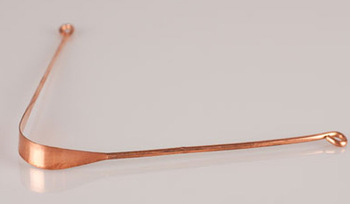 Tongue scrapping can reduce the viral RNA concentration of the tongue and reduce the growth of the virus. Tongue scrapping also stimulates the reflex points of the tongue and removes millions of bacteria growth (approximately 500 varieties). Clinical evidence also shows that use of tongue scrapers on a regular basis, has a significant Improvement on eliminating anaerobic bacteria and it decreases bad odor. It also improves the sense of taste, and stimulates the secretion of digestive enzymes.
Tongue scrapping can reduce the viral RNA concentration of the tongue and reduce the growth of the virus. Tongue scrapping also stimulates the reflex points of the tongue and removes millions of bacteria growth (approximately 500 varieties). Clinical evidence also shows that use of tongue scrapers on a regular basis, has a significant Improvement on eliminating anaerobic bacteria and it decreases bad odor. It also improves the sense of taste, and stimulates the secretion of digestive enzymes.
Moreover, recent researches observed that high viral loads in saliva plays a critical role in viral transmission. Tongue scrapping can reduce the viral load and reduce the rate of viral transmission.
4. Taking Vitamin C in Amla to Fight COVID-19
In Avurveda, the well-known herb, Amla (Emblica officinalis)) is considered a general re-builder of tissues and enhancer of throat and oral health. Amla works well as a mouth rinse. Amla powder, one to two grams of per day can be taken orally with warm water or in capsules for immunity. It also keeps the mouth, throat and lung strong and healthy. Amla supports the healing and development of connective tissue when taken internally.
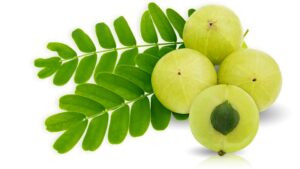 Researchers observed that regular use of Amla (Emblica officinalis) improves immunity, fight against diseases like influenza, chronic cough and cold, infections, fatigue and chronic inflammatory conditions. It improves the immune system by enhancing the activities of the natural killer cells (T cells) and macrophages .
Researchers observed that regular use of Amla (Emblica officinalis) improves immunity, fight against diseases like influenza, chronic cough and cold, infections, fatigue and chronic inflammatory conditions. It improves the immune system by enhancing the activities of the natural killer cells (T cells) and macrophages .
5. Taking Ajwain, Cloves and Black Pepper
Ajwain, cloves and black pepper are natural remedy of cough and could. They are also used to improve the immunity and cure many diseases. Researchers observed significant health benefits of ajwain seeds.
Ajwain or Carom seeds have powerful antibacterial and antifungal properties. They are reported to prevent coughing and improve airflow in the respiratory tracks, and have anti-inflammatory effects. Cloves are hailed in Ayurveda as great immunity enhancer and they reduce the oral inflammation and bacteria. Researches shows that clove oil express significantly inhibitory effects on numerous kinds of microorganisms, and the mechanisms are associated with reducing the migratory and adhesion and inhibiting the synthesis of biofilm and various virulence factors of these microorganisms.
Black pepper is a warming spice that is excellent for pacifying Kapha (cough and cold). It also helps pacify Vata and increases Pitta (associated with immunity and metabolism), according to Ayurveda.
Moreover, antiviral effects of popular Ayurveda herbs like Ashwagandha, Neem, Giloy and Tulsi are well known but its exact effect on coronavirus needs further studies.
Conclusion:
In this article, we discussed some Ayurveda-based preventive and remedial measures for protecting against the coronavirus. Since there is no vaccine as of date, and people are suffering, with large scale panic prevailing everywhere around the globe, I think Ayurveda can come out with some hope to prevent the pandemic from spreading.
Read more ..
